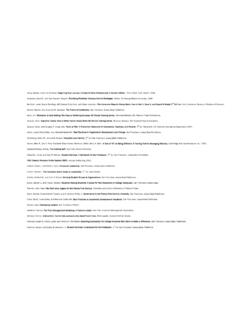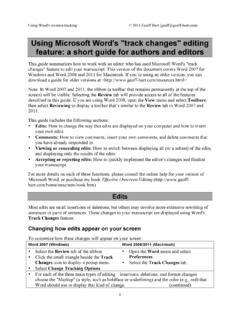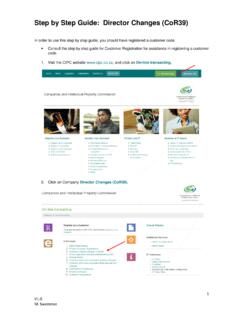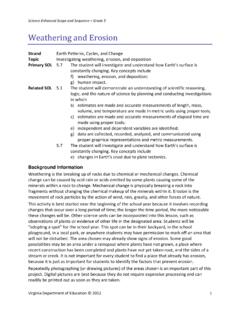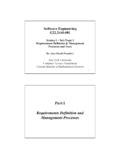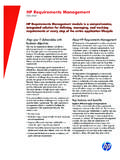Transcription of A Guide for Tactical Planners - University of Scranton
1 The University of Scranton Planning Office A Guide for Tactical Planners December 2009 2 Table of Contents Introduction .. 3 Building the Plan Getting Started .. 4 Plan Approval/Endorsement .. 7 Monitoring and Reporting Progress .. 8 Linking Planning & Assessment .. 8 Linking Planning & Budgeting .. 9 Planning & Institutional Effectiveness Model .. 11 3A Guide for Tactical Planners The University of Scranton considers planning a conscious process by which an institution assesses its current state and the likely future condition of its environment, identifies possible future states for itself, and then develops organizational strategies, policies, and procedures for selecting and getting to one or more of them (Peterson1). The University has adopted a three-level model to structure its planning The University s Planning Office guides and provides primary support to institutional planning activities.
2 The first level of the University s Planning & Institutional Effectiveness model describes the strategic planning process, planning which broadly considers the University as a whole, carefully addresses external environmental factors along with internal observations, and covers a five-year period. The second level, the Tactical planning process, considers the needs and activities of a specific division or other cross-divisional area of the organization (such as Civic Engagement and Enrollment Management), along with how the division/area supports the broader scheme of institutional strategic planning. Operational planning, the third level, occurs within each individual department on an annual basis, and is reflected in the Annual Reporting3 process. Operational planning is built around the identification and fulfillment of objectives that can be completed within one year. It supports the fulfillment of goals described in Tactical plans, and reflects the routine needs of the department.
3 Through their Annual Reports, individual departments report their accomplishments as they relate to the University s Strategic Plan and any relevant Tactical plans. The Planning Office assists each planning area with a cyclical institutional effectiveness survey. These results, along with other pertinent assessment findings, will inform the planning process at each level. Tactical Planning As defined by Norris, Tactical planning consists of the short-term or intermediate-term, regular planning and budgeting activities dealing with administrative and operational activities that unfold within the overall strategic context of objectives established by strategic planning (9)4. At the University of Scranton , a Tactical plan contains the priorities, goals, and objectives outlined in a divisional or other campus-wide intermediate range (average 3 years) plan. While strategic planning focuses on identifying broad statements of institutional focus in specific areas, Tactical planning serves three more functional purposes.
4 First, it helps each division/area identify and commit to ways it can serve the University s mission, vision, and strategic plan. It also identifies the key priorities of the individual division/area statements which define the nature of the division/area and its relationship with those it serves , and establishes particular goals necessary to meeting these needs successfully. Third, Tactical planning identifies clear and specific objectives for fulfilling these goals, activities that have measurable results. 1 Peterson, Marvin. Analyzing Alternative Approaches to Planning. ASHE Reader on Planning and Institutional Research, 1999. 2 See attached. 3 For more information on the Annual Report process, see 4 Norris, Donald and Nick L. Poulton. A Guide for New Planners . The Society for College and University Planners , 1991. 4 Tactical planning allows divisions/areas to prioritize their needs and activities over a three year period, ensuring that annual operations consider what relationship exists between decisions/activities made in one year and future goals and events.
5 Though the scope of the plan covers three years, the plan should be reviewed annually to ensure that progress is being made and monitored, that goals and activities remain relevant to the division or administrative area s changing needs, and that the plan is actively supporting the University s Strategic Plan. Tactical planning is not meant to burden divisions/areas with additional work, but rather to organize thinking and planning that often takes place on a less centralized basis, making planning a proactive, rather than reactive, activity. It emphasizes forward thinking in everyday activities, and provide divisions/areas with touchstones to mark their progress. Tactical planning also serves a very functional purpose that of providing a process for aligning the University s annual budgeting processes to its planning efforts. The Planning Office serves as a support resource for the divisions/areas developing Tactical plans. The Office provides research support, facilitates planning meetings, and supports other processes that are part of the planning process.
6 Building the Plan Getting started. Planning is different from just thinking ahead. All areas of an organization consider their needs and aims for the future, but the activities of planning compel persons and/or groups to prioritize and commit to needs for a specific period. It helps to provide some framework for the prioritization and allocation of resources. Rather than being an exercise that is reactive to market or other business concerns, planning is proactive, attempting to align an institution with its environment, and helping it to capitalize on external opportunities and minimize its vulnerability to threats. It is informed by careful research and analysis, and is kept on track by consistent measurements of progress/success, benchmarking, and the tracking and reporting of results. Rather than any of these steps being end points in and of themselves, as they may be in the more traditional ad hoc processes of thinking ahead, each contributes to a continuing process similar to that established by W.
7 Edwards Deming and followed closely by effective organizations: plan, do, check, and act5. Plan to plan. Organizing core planning staff is an essential first step of the planning process. This group should consist of persons with management responsibility within the division and its subsequent departments, or key stakeholders in the case of organizational areas. The group should study the University s mission and goals, the Planning and Institutional Effectiveness model, the current University Strategic Plan and, if they have not already, familiarize themselves with the Annual Report process. 5 Watson, Strategic Benchmarking: How to Rate Your Company s Performance Against the World s Best. New York: Wiley, 1993. Alstete, Jeffrey. Benchmarking in Higher Education: Adapting Best Practices to Improve Quality. ASHE-ERIC Higher Education Reports, 1995. 5 Explore your relationship to the communities in which you do business.
8 Tactical planning is designed to support the mission, vision, and strategic plan of the institution. However, it also serves as a practical way for divisions/areas to strive for success and improvement in their own unique service areas. The group should first discern its role within the University . What is its core mission? Can it articulate a clear vision for what its role will be in the future? Forming answers to these questions and presenting statements that describe the answers will later be important in determining the value of possible Tactical goals and objectives. Once these essential questions about its internal role(s) are answered, the Tactical planning group must explore its external environment. Environmental scanning is an excellent way to begin this process. Do your homework. Environmental Scanning is defined as the acquisition and use of information about events, trends, and relationships in an organization s external environment, the knowledge of which would assist management in planning the organization s future course of action (Choo 84), and is a crucial part of any planning The Planning Office completes environmental scanning reports with a University -wide scope on a regular cycle, presenting analysis of issues that may impact the institution as a whole.
9 7 The Office maintains extensive scanning related materials, and can serve as a resource for research on a variety of subjects. To begin the scanning process, determine what critical issues the field/discipline of the administrative area doing the planning will face in coming years from both the macro and micro environments. Look for trends and signs of change. When putting together the final report, be sure to present the issues at hand with an eye to how they will specifically impact the institution and the particular area doing the planning. Along with examining external trends, the planning group should take a look at their own backyard the institution which they are part of. Identify key stakeholders, and ask them to consider what needs or issues they see rising in the context of your division/area s Tactical plan. Those doing the planning should also consider relevant documents and processes, for example, institutional Periodic Review and Self Study reports and reviewer responses from The Middle States Commission on Education.
10 They may ask themselves what events or issues on campus are clamoring for attention. And, they will want to consider what successes and gains the institution has enjoyed in recent years. Engage in critical analysis. Information is only as valuable as the way in which it is used. After an environmental scan is completed, be sure to share it with the planning group and any other community members or groups who may be able to react to it with insight. Engaging in a SWOT analysis is an essential next step. SWOT analysis is a process whereby an organization considers its internal strengths and weaknesses in relationship to external opportunities and threats. A successful SWOT analysis will demonstrate how well the division/area is or is not aligned with critical factors of its internal and external environments. With these findings in mind, the area doing the planning should be able to identify the issues to which they should and can respond, and determine the way(s) in which that response should be structured.









